The Hungarian Kitchen (Budapest edition): Lecsó
The Hungarian Kitchen (Budapest edition): Lecsó
-
-
-
-
-
The Hungarian Kitchen (Budapest edition): Lecsó
-
Post #1 - January 7th, 2011, 12:37 amBeing back in Budapest for the first time in almost three years, I realized it's been a long time since I've contributed to the recipe section of this site, so here's the next installment of the Hungarian Kitchen:
Lecsó (also, letscho, letcho, or lecho, depending on the transliteration) is a dish sometimes called "Hungarian ratatouille," consisting of a stewed mix of peppers, tomatoes, and onions. Often, it is fried on lard and/or smoked bacon fat, although vegetarian sunflower oil variations exist. It may be eaten on its own or as a side, at any time of day. For breakfast, it may be topped with a fried egg or two or scrambled along with them. For lunch or dinner, it may be eaten on its own with bread, or supplemented with a sausage, meat, noodles, etc. During the winter, canned and preserved lecso can be used in Hungarian stews to substitute for out-of-season peppers and tomatoes.
I'm going to make a rich version of lecsó, using both lard and smoked bacon fat. The proportion of the ingredients should be roughly 2:1:1 by weight of peppers:tomatoes:onions.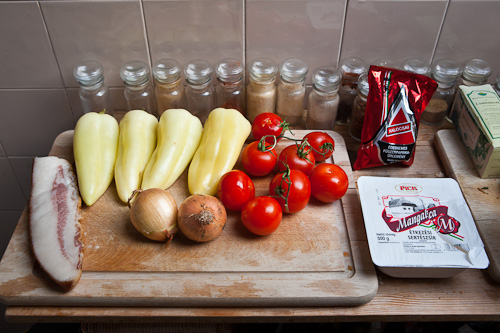
From the left: Smoked Mangalica bacon, sweet Hungarian peppers, onions, tomatoes, Hungarian paprika from Kalocsa, Mangalica lard. Mangalica is a local breed (or several breeds) of curly-haired pig raised mostly for its fat and well-marbled meat. If you complain that commercial pork is too lean these days (and it is), this is your breed. More info here. I'm sure a number of posters here are familiar with it, as it has made inroads into the American market the last few years, usually under the spelling Mangalitsa. Incidentally, from my observation, it also seems to have surged in popularity here in Budapest, as well, with Mangalica being much more heavily promoted and available than it was in the late 90s/early 00s.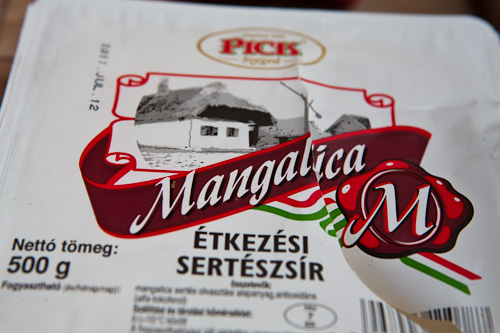
Chop the onions into dice or half slices, and fry with the lard and bacon fat (or use sunflower oil if you're vegetarian). I used about 1/8 of the bacon pictured above, and about two teaspoons of lard. I let the bacon and lard cook first, to render the fat from the lard, and then added the onions.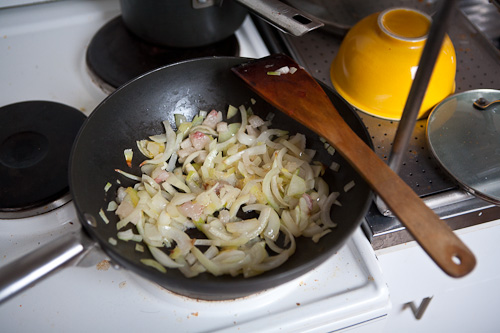
After the onions soften into translucency, I add a teaspoon of paprika (sweet, hot, or a mix can be used. I used sweet here). (Added 10/2/14 -- These days, I would suggest cooking the onions down even farther. Some cooks suggest caramelizing them. I don't take them quite that far, personally, but I do get them somewhat browned, where the flavor begins to change and get more roasted and sweet. I'm thinking like Big Baby-levels of onion brownness.) The amount is flexible, but I added one teaspoon for what was about a half pound or so of onions. Take the pan off the heat while you do this, so as not to burn the paprika: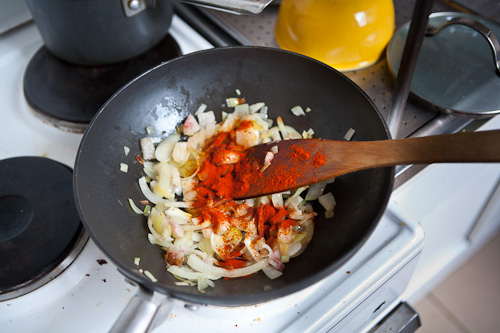
Integrate the paprika with the fat and onions, and let cook for about a minute off the heat. Afterwards, add your peppers and tomatoes. For best results, you should use a mix of peppers, in terms of color and heat level, but in my case I just used standard Hungarian sweet peppers. These are peppers that are similar to sweet versions of Hungarian wax, banana peppers, or Italian frying peppers in the States, but with rather meaty flesh--about as fleshy as a standard bell pepper, but with a milder flavor. If forced to use bells, I think yellow bells or a combination of yellow and red would work the best. Cut the peppers in strips or one-inch half rings (as I did).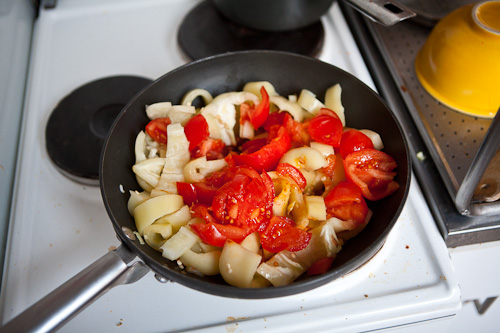
I used about half the tomatoes pictured in the ingredients photo. The tomatoes should be, ideally, peeled and chopped or sliced, but I'm a bit lazy and skipped the peeling step.
Add a teaspoon of salt, give the ingredients a good stir, add cover. Let this simmer over medium-low to medium heat until the peppers become soft (around 45 minutes or so). About halfway through the cooking time, I added some slices of lecsókolbász, a type of sausage specifically made for this dish: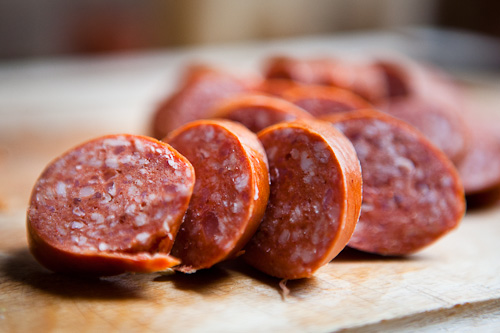
It's actually quite a tame and "cheap" sausage by Hungarian standards (in my opinion), in ways more bologna-like than sausage-like in its texture and taste. I would say it has a similar level of smokiness and consistency to mass-market Polish sausages like Hillshire Farms. I've read Hungarian recipes that have said to leave the lecsokolbasz to the dogs, and use a Debricener or Gyulai sausage in its place. I'm actually fond of it in this application, so in it goes, to stew along with the lecso: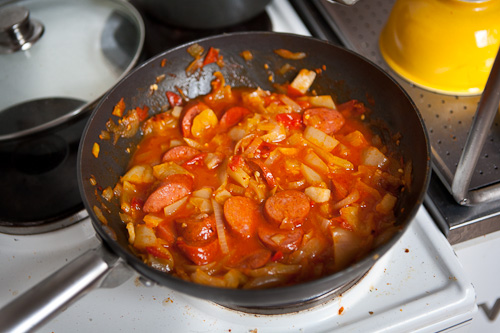
For the last ten minutes or so of cooking time, I remove the lid and let it reduce a little bit. Serve with crusty white bread: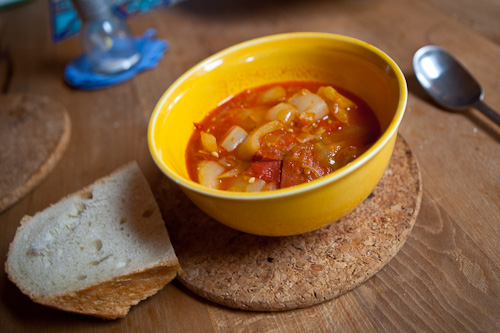
And a postcard from this fair city: Last edited by Binko on October 2nd, 2013, 7:30 am, edited 1 time in total.
Last edited by Binko on October 2nd, 2013, 7:30 am, edited 1 time in total.
-
-
Post #2 - January 7th, 2011, 9:37 amLooks good!i used to milk cows
-
-
Post #3 - January 7th, 2011, 11:22 amGorgeous post, Binko! Thank you so much for keeping your posts alive!
-
-
Post #4 - January 8th, 2011, 9:24 amIf you are not using too many tomatoes, try this - halve and seed them, then flatten and toss into your pan skin down. In a minute or so you should be able to peel the skin off with your fingers. Work fast, they will be hot
 Then tear apart in the pan as desired - this is easier with 2 forks.
Leek
Then tear apart in the pan as desired - this is easier with 2 forks.
Leek
SAVING ONE DOG may not change the world,
but it CHANGES THE WORLD for that one dog.
American Brittany Rescue always needs foster homes. Please think about helping that one dog. http://www.americanbrittanyrescue.org
-
-
Post #5 - January 8th, 2011, 11:33 amThanks for the tip! To be honest, though, I'm always lazy with peeling the tomatoes for lecso. The peels don't really bother me, especially since the peppers are left skin-on. However, most (but not all) of the recipes I've read do say to peel them. I'm not that fussy. It is not necessary to seed them, though. In fact, looking through my notes, I can't find a recipe that calls for the tomatoes to be seeded. Just peeled.
-
-
Post #6 - October 1st, 2013, 12:20 pmRecipe in the weekend Wall Street Journal.
Anyone ever try or make??
Thanks,
Wally Wade
-
-
Post #7 - October 1st, 2013, 12:29 pmA few years ago Binko posted a beautiful piece on lecsó (note spelling).
-
-
Post #8 - October 1st, 2013, 2:34 pmSpelling in the WSJ :: "LESCO".
Check it out 9/28-29/2013. OFF DUTY section. P D5.
SO my question, anyone ever tasted??
Worth the effort to make?
Can you get at a restaurant?
Thanks,
Wally Wade
-
-
Post #9 - October 1st, 2013, 2:50 pmHi,
Having made a few of Binko's recipes, they are always quite wonderful.
Wally, whether you follow's Binko's or the WSJ, you will be happy with the results.
Very like some of the specialized ingredients may be found at:
Bende
925 Corporate Woods Pkwy. . Vernon Hills, IL 60061
(847) 913-0306
Regards,Cathy2
"You'll be remembered long after you're dead if you make good gravy, mashed potatoes and biscuits." -- Nathalie Dupree
Facebook, Twitter, Greater Midwest Foodways, Road Food 2012: Podcast
-
-
Post #10 - October 1st, 2013, 3:14 pmwalter wade wrote:Spelling in the WSJ :: "LESCO".
Check it out 9/28-29/2013. OFF DUTY section. P D5.
SO my question, anyone ever tasted??
Worth the effort to make?
Can you get at a restaurant?
Thanks,
Wally Wade
I guess a couple threads got merged here, so you can see from above that it is a very simple dish. Its success depends very much on the quality of its ingredients. It's not something I would call "mind blowing," but it's very simple fare with clean flavors that can be used in a wide variety of applications. I found the Wall Street Journal article and recipe here. It's very similar to what's above, including the 2:1:1 ratio of peppers:tomatoes:onions. That recipe will serve you fine.
I think it's great, and even better if you're into canning. I'm not a big canner, but I would make lecsó in September-ish when I lived in Budapest in large numbers because peppers and tomatoes were dirt cheap and tasted like heaven. It was great when I wanted to make a quick meal or use as part of a pörkölt (Hungarian stew/goulash) recipe when tomatoes and peppers were out of season.
And feel free to use hot peppers, if you wish. Anaheims or New Mexico chiles would be perfect for lecsó.
Hmm...now I'm in the mood for lecsó.
-
-
Post #11 - October 1st, 2013, 3:16 pmRene G wrote:A few years ago Binko posted a beautiful piece on lecsó (note spelling).walter wade wrote:Spelling in the WSJ :: "LESCO".
Check it out 9/28-29/2013. OFF DUTY section. P D5.
SO my question, anyone ever tasted??
Worth the effort to make?
Can you get at a restaurant?
Thanks,
Wally Wade
We're both right:In the Corrections & Amplifications section, Wall Street Journal wrote:Hungarian stew discussed in an Off Duty article on Saturday is called lecsó. The name was misspelled as lescó.
I've made it before but never with the sausage (looks like a great addition though). It tastes just as good as it sounds and is really not difficult. This seems like a perfect time of year for lecsó—it should be possible to find good peppers and tomatoes at the farmer's markets and it's not too hot to enjoy such a hearty dish. I might have to try the WSJ chicken recipe. As for restaurants, I'm not aware there are any Hungarian places left in Chicago.
-
-
Post #12 - October 1st, 2013, 4:13 pmRene G wrote:Rene G wrote:A few years ago Binko posted a beautiful piece on lecsó (note spelling).walter wade wrote:Spelling in the WSJ :: "LESCO".
Check it out 9/28-29/2013. OFF DUTY section. P D5.
SO my question, anyone ever tasted??
Worth the effort to make?
Can you get at a restaurant?
Thanks,
Wally Wade
We're both right:In the Corrections & Amplifications section, Wall Street Journal wrote:Hungarian stew discussed in an Off Duty article on Saturday is called lecsó. The name was misspelled as lescó.
I've made it before but never with the sausage (looks like a great addition though). It tastes just as good as it sounds and is really not difficult. This seems like a perfect time of year for lecsó—it should be possible to find good peppers and tomatoes at the farmer's markets and it's not too hot to enjoy such a hearty dish. I might have to try the WSJ chicken recipe. As for restaurants, I'm not aware there are any Hungarian places left in Chicago.
My mom never used sausage but always added eggs. Must be regional.
-
-
Post #13 - October 1st, 2013, 4:26 pmspinynorman99 wrote:My mom never used sausage but always added eggs. Must be regional.
I wouldn't be surprised, but it's not really a dish that is served in one manner, either, so it's possible that your mother just made the variation she liked the best. It's more of a side dish or part of a dish that gets used a million different ways--kind of like salsa or New Mexican green chili sauce or whatnot. I can't really say I personally encountered lecsó with sausage all that often in Budapest, but every single deli sold lecsókolbász (sausage for lecsó), so somebody must have been using it. Most often, I would see it served as your mother did: with eggs, on its own, or with a pebbly little type of pasta called tarhonya.
Most often, I would see it served as your mother did: with eggs, on its own, or with a pebbly little type of pasta called tarhonya.
-
-
Post #14 - October 1st, 2013, 7:44 pmMy magyar mother always serves it with good bread and with sausage cut in (when Mulsim dad isn't home), or otherwise vegetarian. Never had it with eggs. Sounds delicious. On top of tarhonya sounds even better."By the fig, the olive..." Surat Al-Teen, Mecca 95:1"
-
-
Post #15 - October 1st, 2013, 7:47 pmwalter wade wrote:Spelling in the WSJ :: "LESCO".
Reason number 1392851908238409182340918 that the WSJ is F'in imbecilic."By the fig, the olive..." Surat Al-Teen, Mecca 95:1"
-
-
Post #16 - October 1st, 2013, 9:38 pmBinko wrote:spinynorman99 wrote:My mom never used sausage but always added eggs. Must be regional.
I wouldn't be surprised, but it's not really a dish that is served in one manner, either, so it's possible that your mother just made the variation she liked the best. It's more of a side dish or part of a dish that gets used a million different ways--kind of like salsa or New Mexican green chili sauce or whatnot. I can't really say I personally encountered lecsó with sausage all that often in Budapest, but every single deli sold lecsókolbász (sausage for lecsó), so somebody must have been using it. Most often, I would see it served as your mother did: with eggs, on its own, or with a pebbly little type of pasta called tarhonya.
Most often, I would see it served as your mother did: with eggs, on its own, or with a pebbly little type of pasta called tarhonya.
Grew up with tarhonya/farfel as a ubiquitous side dish.
-
-
Post #17 - October 2nd, 2013, 7:27 amSo guess what I had for dinner last night?
 Since it's in the neighborhood, I was in Bobak's yesterday, but they didn't have any Hungarian wax or banana peppers. They did have some kind of pale green-ish yellow-ish bell pepper, though, along the lines of this gypsy pepper. I'm not entirely sure what kind of pepper it was, as it was unmarked, but it was exactly the same shape as the red, green, and yellow bells there. At any rate, that pepper worked really well for the dish, being in the right ballpark of flavor I remember Hungarian sweet peppers being: lightly sweet, mild pepper flavor (as in, they don't have that strong "green/grassy" chlorophyll or whatever it is flavor green peppers have, and they don't have the characteristic sweetness and flavor of reds.) I made them with Bobak's Veal Frankfurters, which would make the recipe virslis lecsó in Hungarian. ("Virsli" basically meaning "hot dog.") Plus, for breakfast this morning, I scrambled a couple of eggs and added a bit of the frankfurter lecso to it, along with a healthy dollop of sambal oelek (as I'm out of the Hungarian pepper paste.)
Since it's in the neighborhood, I was in Bobak's yesterday, but they didn't have any Hungarian wax or banana peppers. They did have some kind of pale green-ish yellow-ish bell pepper, though, along the lines of this gypsy pepper. I'm not entirely sure what kind of pepper it was, as it was unmarked, but it was exactly the same shape as the red, green, and yellow bells there. At any rate, that pepper worked really well for the dish, being in the right ballpark of flavor I remember Hungarian sweet peppers being: lightly sweet, mild pepper flavor (as in, they don't have that strong "green/grassy" chlorophyll or whatever it is flavor green peppers have, and they don't have the characteristic sweetness and flavor of reds.) I made them with Bobak's Veal Frankfurters, which would make the recipe virslis lecsó in Hungarian. ("Virsli" basically meaning "hot dog.") Plus, for breakfast this morning, I scrambled a couple of eggs and added a bit of the frankfurter lecso to it, along with a healthy dollop of sambal oelek (as I'm out of the Hungarian pepper paste.)
The only addendum I would make to this recipe is that I like to cook down the onions a bit more than just translucent these days. I don't fully caramelize them, but I do get them somewhat brown, where they start developing that caramelized flavor (maybe 10 minutes or so over medium-high heat, stirring often). I see one of the comments in the WSJ article mentions this. (I'll make a note in the original recipe for future reference.)
Despite the initial misspelling of "lecsó" in the article, the WSJ piece is surprisingly on the mark, even suggesting sunflower oil as the fat.
-
-
Post #18 - September 21st, 2014, 3:33 pmI went to the Evanston Farmer's Market yesterday with this thread in the back of my mind, thinking that this would be the right time of year to try this recipe. I didn't expect that I would be able to find both Hungarian sweet and Hungarian strong peppers - but I did! Some of peppers were almost too pretty to eat. I used Bende's smoked bacon which has a very, very strong smokey taste.
We had this for dinner with a couple of eggs stirred in at the end. The eggs added smoothness. This seems to me to be a great recipe to take advantage of the end of summer bounty."I live on good soup, not on fine words." -Moliere
-
-
Post #19 - September 24th, 2014, 11:02 amLooks good to me, glad you tried it! This time of year is pretty much exactly right for lecso-making. I made a couple potfulls a couple weeks ago myself to use up a batch of tomatoes. I really should get back into canning, because lecso is perfect for that. (But it freezes well, too.) I used store-bought cubanelles with tomatoes from the garden. I need to remind myself to grow some sweet peppers for a change next year.

-
-
Post #20 - September 24th, 2014, 11:35 amThanks, Binko. Glad to know I got it right."I live on good soup, not on fine words." -Moliere

